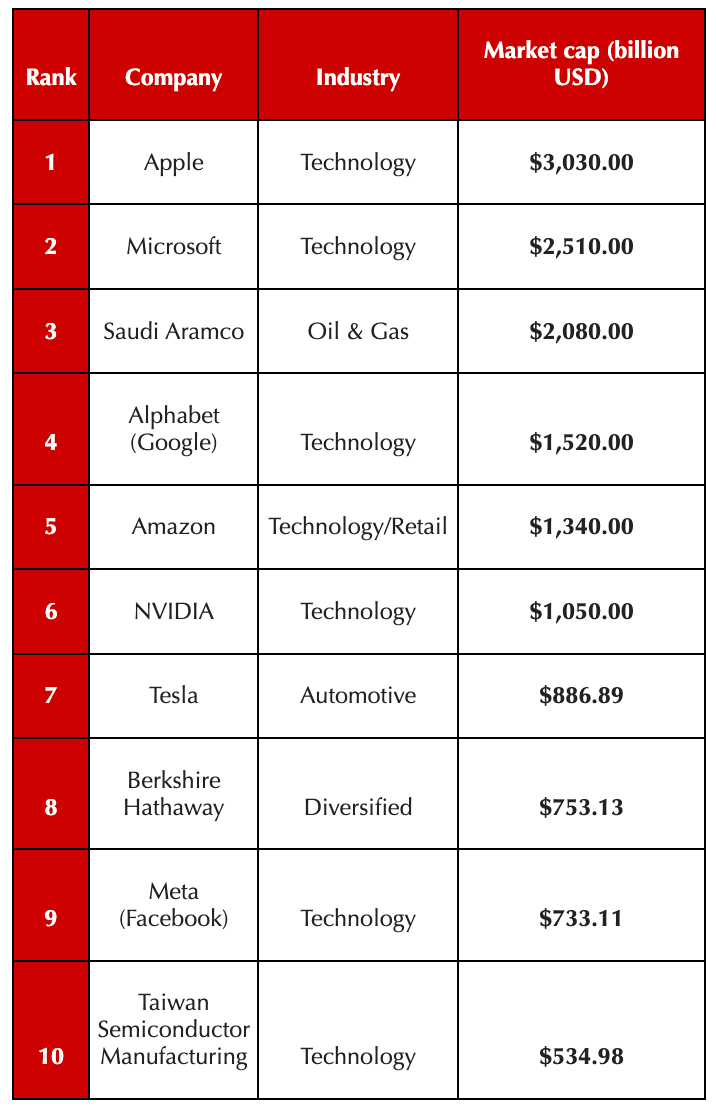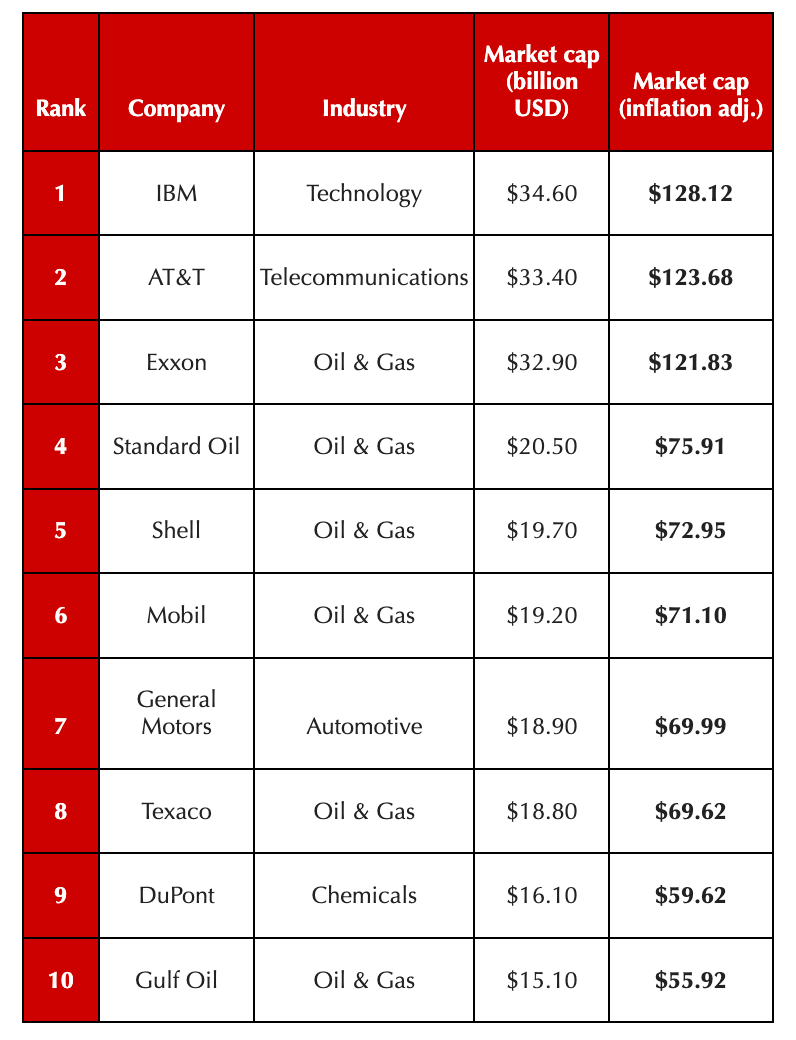Bigger than Jesus: Here’s the universe’s Top 10 most valuable companies today, in 2000 and back in 1980

Via Getty
Apple shares fell again overnight. We don’t often say that.
The iPhone purveyor which made history when it recently became the world’s first US$3tn company, has managed to remain ensconced at the top of the universal corporate pile with its endless expansion and reinvention into new markets and sectors, amid signs of improving inflation.
Overnight, Apple unveiled a new panopoly of toys at its annual event (they called this one ‘Wonderlust’) including the new iPhone 15 series and a few watches and such.
But it’s getting harder to wow the kids in the age of AI.
According to all measures, APPL is still the biggest in the world by a long, long way – and even with Chinese officials swallowing a ban on iPhone products, there doesn’t look to be any insurgent company threatening Apple’s lofty spot on the tree.
With this in mind, a score of analysts at City Index pulled out the slide rule to make comparative indices on the biggest companies in 1980, 2000 and today by market cap, providing an interesting bunch of companies who dominated their respective eras, and thus helping you dear reader, establish how significantly markets and stocks have morphed over the last 40 years.
The method undertaken involved heaping together market cap/revenue of each company for each year, obtained or inferred in accordance with historical data either from City Index’s own archives or from readily available sources, then cross-referenced market cap values and tweaked when needed in accordance with multiple readily available sources.
Analysis was then conducted on the top companies of each year to assess their performance and determine the factors contributing to their sustained dominance.
So without further ado…
The top 10 biggest companies right now:

In an era rife with smartphones and AI, it’s no shock that technology dominates the stock market in 2023, with seven technology companies including Apple, Amazon and Tesla occupying the top 10.
According to City Index, it’s still Apple, the world’s most outrageously valuable company in history.
Even after dumping another uninspiring iPhone “update” on the waiting world yesterday, the House of Jobs currently holds a market cap of circa US$3.03 trillion.
Apple was founded in 1976 and went public in 1980.
Only in 2011 did it become the world’s most valuable company for the first time, with a value of $350 billion, when it displaced the oil-sucking juggernaut ExxonMobil at the top of the pops.
Apple stayed the biggest company in the world for most of the 2010s, and in 2018 became the first US company to surpass $1 trillion in value. Apple passed US$2 trillion 24 months later.
Micro-second
With a market cap of US $2.51tn, Microsoft is the galaxy’s second-biggest company in 2023.
The ubiquitous and market-leading Azure cloud computing services and the firm’s stake in OpenAI have kept Microsoft right up there.
However, the products that saw it dominate in 2000 – including Windows and Office – are still a big part of its revenues.
Still, Microsoft was very much once the world’s most valuable company. Back in 2000 and adjusted for inflation, MSFT’s market cap according to CityIndex calculations was equal to a bit over a trillion US dollars.
It’s now worth over three times that.
The top 10 biggest companies in 2000:

Much like today, technology companies had prominence on the stock market in 2000. Companies like Microsoft, Cisco and Intel occupied half of the top 10, compared to only one (IBM) 20 years earlier. Only two Oil & Gas companies were in the top 10 in 2000, ExxonMobil and Royal Dutch Shell.
In 2000, Microsoft was top of the stock market, worth US$586 billion ($1.03 trillion today) however, it was badly affected by the dot-com crash.
By March 2001, its value had dropped to US$258 billion, less than half of its peak. This was partly due to the ruling of the United States vs. Microsoft judgement, in which MSFT was found guilty of monopolisation. A judgement which helped usher in names like Google, which many believe is having its own MSFT moment in court with the US right now.
Yet MSFT made a stellar recovery, regaining pole position in 2003, when it became the biggest company in the world again, and the biggest tech company in the world up until Apple’s astonishing rise in the early 2010s.
The top 10 biggest companies in 1980:

Unsurprisingly and much like popular hair-styles, the biggest companies 40 years ago looked a vastly different bunch from those of 2000 and today… although you’ll likely recognise the names.
Back in 1980, Technology hadn’t yet dominated the stock market, instead, it was all about who had their hands on the energy – namely Oil and Gas.
The sector was a key force across economics, politics and well, everything, with no less than six Oil and Gas companies occupying the top 10.
Yet it was the computer maker IBM which was the world’s biggest company in 1980, wielding around a market cap of US$34.6 billion ($128.12 billion today).
However, the times were about to get tougher for IBM, as the first rays of technological innovation shone a world of competition onto the personal and business computing sector which IBM had come to dominate.
New entrants to the market challenged its crown, and by 1981 it was no longer at the top of the stock markets.
But, not unlike MSFT by the mid-1980s, IBM or ‘Big Blue’ was back and dominant once more.
Today though it’s lagged badly, underperforming the wider market and is now worth with about US$130 billion today – roughly the same as its cap in 1980 when adjusted for inflation.
Related Topics
UNLOCK INSIGHTS
Discover the untold stories of emerging ASX stocks.
Daily news and expert analysis, it's free to subscribe.
By proceeding, you confirm you understand that we handle personal information in accordance with our Privacy Policy.








